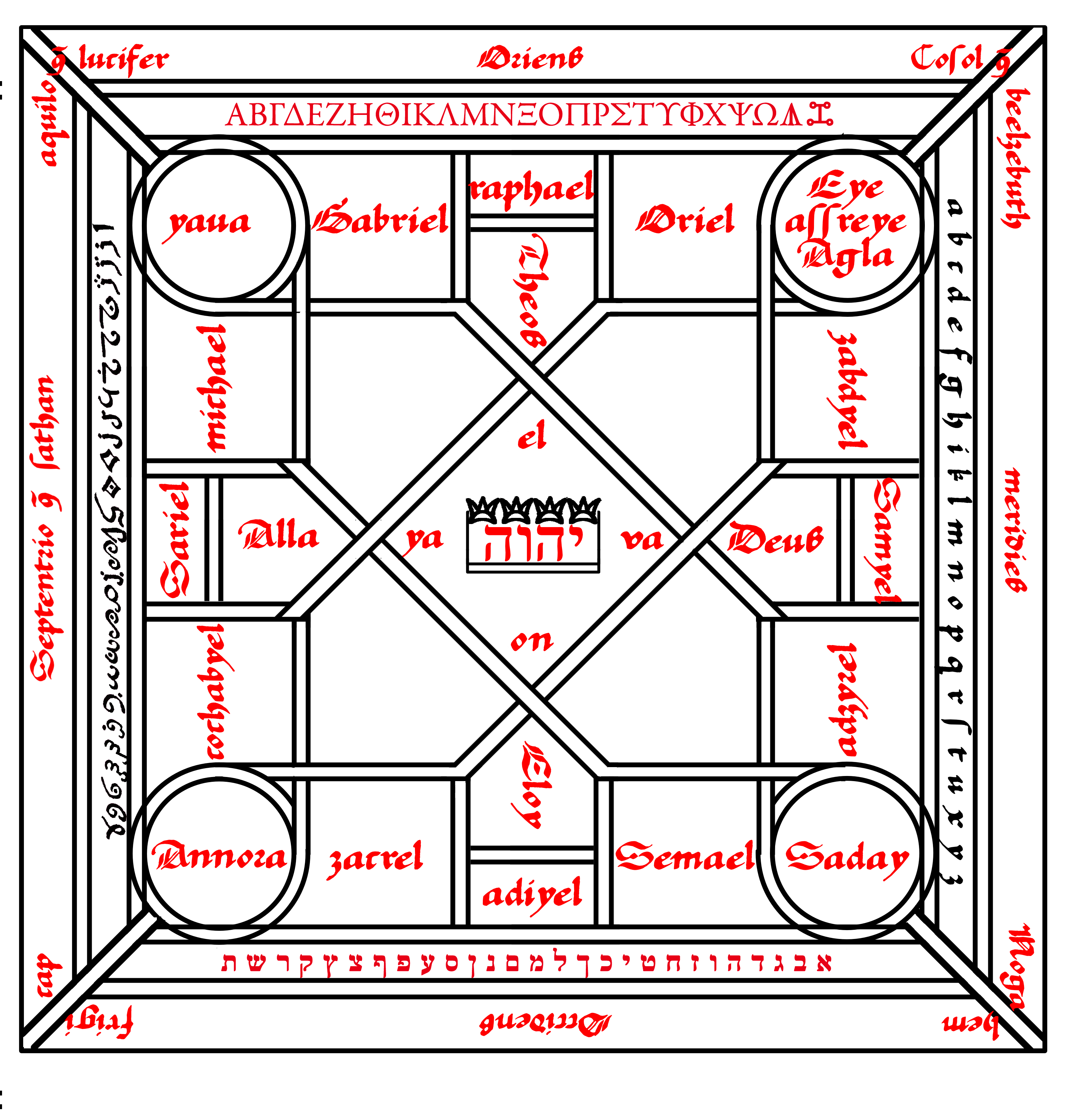The Semamphoras table
Joseph H. Peterson, Oct 07, 2024; updated Jan 4, 2025.
According to Ganell, this table (or sigil) is to be written on parchment
(deer or calf) using saffron, rose water, and musk. (L.2.f.14) It is to be held in the hand while
making a petition to God. (See also Veenstra, “Honorius and the Sigil of God”
in Claire Fanger, Invoking Angels, 2012, p. 173.)
Note the border of the Sememphoras table includes the four alphabets –
Latin, Greek, Hebrew, and “Chaldaean or Arabic” - used to extract the names of spirits.
One of Ganell's core theories and themes is the use of tables of “astral alphabets”
to construct “wonder-working words.” (Gehr, Damaris Aschera, “Berengarius Ganellus and the Summa Sacre Magice – Magic as the
promotion of God’s Kingship” in Page, Sophie, and Catherine Rider. The Routledge History of Medieval Magic. 2021, p. 246).
According to Ganell, "the great table of
this art is called the "table of the four sects", which is
composed from the four alphabets, Greek, Hebrew,
Latin, and Arabic."
Understand moreover that the general rule of
magic is, that as the sects, so are the magi. And
each sect has its magic. So if the sect is
Christian, the magus is Christian; if Saracen, a Saracen
magus. ¶ And if the sect is Hebrew, a magus is Hebrew.
¶ And if the sect is Pagan, a Pagan magus. ¶ And it is
not possible to have more than one sect authentically,
so one cannot be more than one kind of magus. ¶ The
Christian magus uses Latin letters principally, with the
others subsequently. The Saracen magus uses Arabic
letters firstly, others secondarily. The Jewish magus
uses Hebrew letters earlier, others next. ¶ The Pagan or
Gentile magus uses Greek letters originally, and others
next. ¶ And all magic has these two distinguished
foundations: the letters of the sects, and the faith of the
sects. ¶ In the letters and the sect, first in the alphabet
from the sect, and in the same faith is founded all
magic, firstly and principally. ¶ And the faith of the sect
is the faith in God, because no sect has denied God,
and each sect acknowledges him. And for this reason,
each sect has names which it uses to call upon God,
and with those names it is able to constrain the
enemies of God. Therefore the holy Honorius in
The Sworn Book
has said, that faith works for each person,
whether for good or evil. Because the faith of an evil
sect is called evil, and of the good, good.
¶ And of those sects, the first is the Pagan, which
extols the planets, and they call those gods, such as the
god Saturn, and the god Mars, and the god Jupiter. The
Romans were likewise pagans.
¶ The second is Hebrew, and they believe in the one
true God, but not the Trinity.
¶ The third Christian, which professes the Trinity
and Unity.
¶ The fourth is Muslim. (—Kassell ms, L.4.f.49.)
See also Kassell L.5.f.13-f.18,
with the method of extracting of the names of spirits starting on L5.f.22 (most of which is now missing).
A much later example of its design and ritual use can be found in the
VSG manuscript (ca 1550),
pp. 22-24. See translation in my Elucidation of Necromancy, 2021, pp. 133-137.
Another later example can be found in the ASV case file (ca 1630),
Archivio di Stato di Venezia, Sant'Uffizio, b.93.
Title: Occultissimorum Liber / Orationes Semiforas Septem Altitudines / Liber de Secrettis secretorum Mundi et
Duodecim Altitudines Salomonis,
p. 20.
|
|
|
Aquilo contra Lucifer: Northeast against (or "facing") Lucifer
Oriens: East
Cosol contra Belzebuth: Cosol (Southeast) against (or "facing") Beelzebuth
Meridies: South
Nogahem: Southwest
Occidens: West
Frigicap: Northwest
Septentrio contra Sathanam: North against (or "facing") Satan
|
![[halle_14B36_f218v_tabula_new]](halle_14B36_f218v_tabula_new.jpg)
